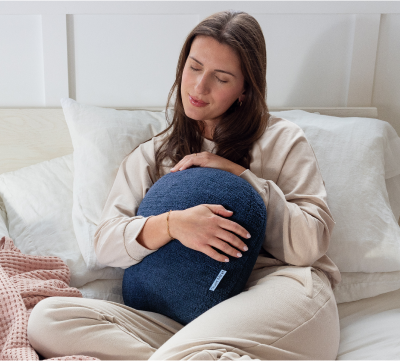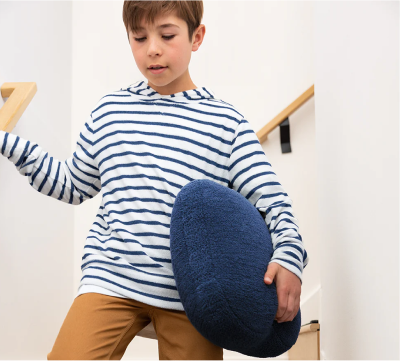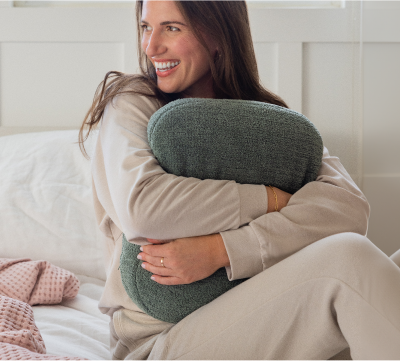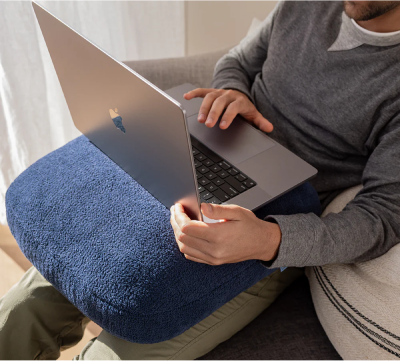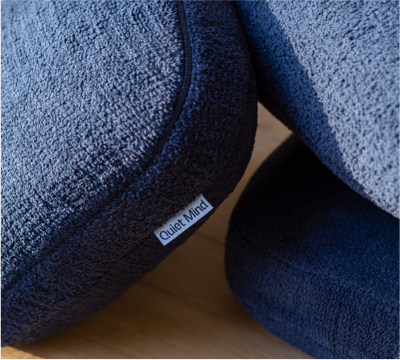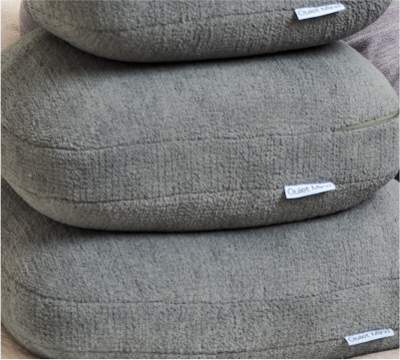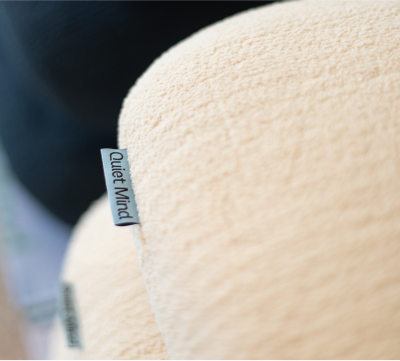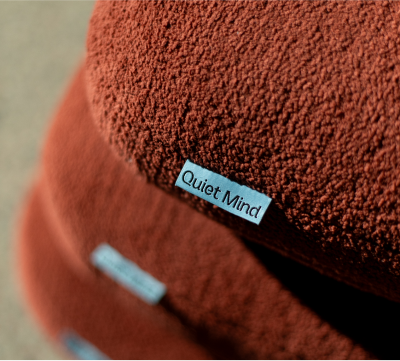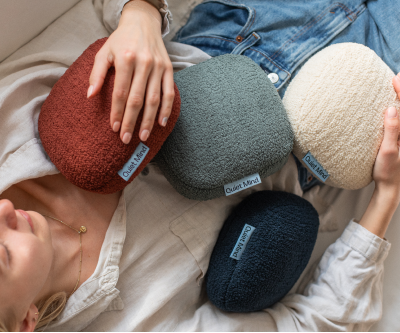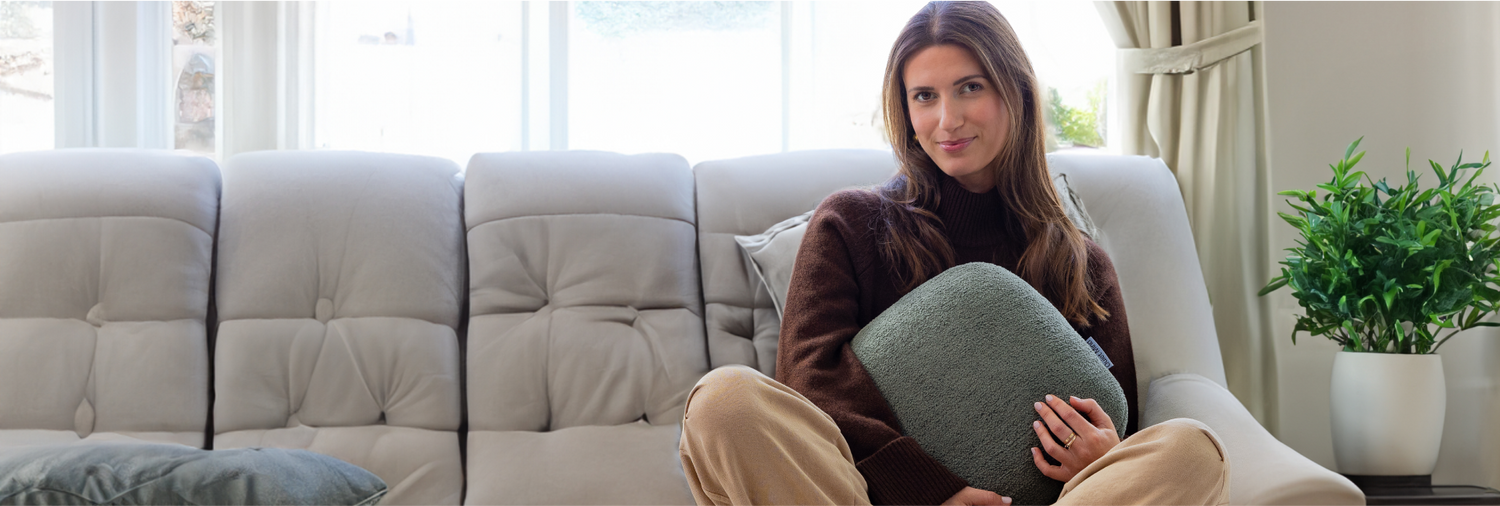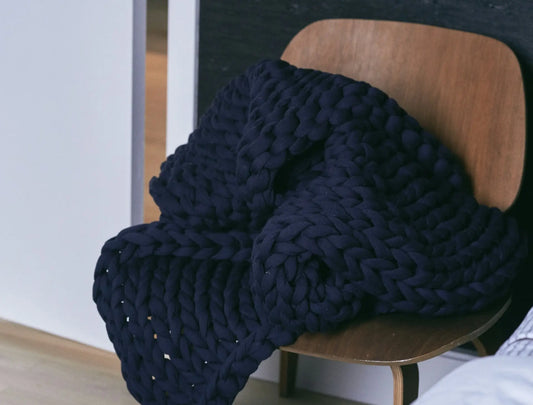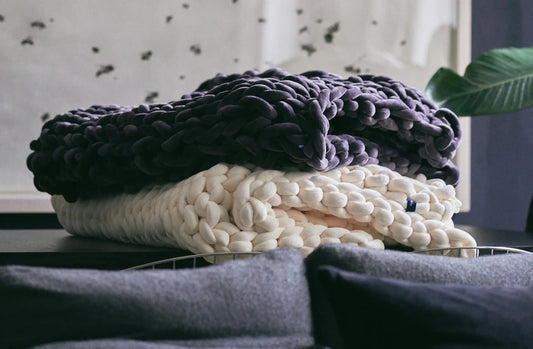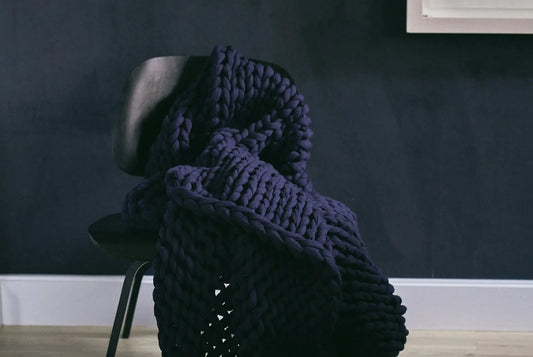Calm doesn’t always begin with a dramatic shift. Sometimes, it starts with something simple: steady pressure, a sense of being held. This is the quiet comfort of a weighted blanket.
Whether you're trying to manage insomnia, regulate sleep patterns, or ease the tension of a long day, weighted blankets are a popular tool for grounding the nervous system. But how long should you stay under one? And what’s the safest way to include it in your sleep routine?
This guide explores how long to use a weighted blanket, how it may support your body and mind, and how to choose the right fit for safe, effective use. And if a blanket feels too heavy or impractical, we also introduce an alternative: weighted pillows, which can provide the same calming benefits in a more flexible, everyday form.
What Does a Weighted Blanket Do for Your Body and Mind?
Weighted blankets work by providing deep touch pressure, a gentle, evenly distributed sensation that mimics the feeling of being hugged or held. This type of input is often calming to the nervous system and may help lower cortisol levels while encouraging the release of serotonin and melatonin, both connected to sleep habits and mood regulation.
The added weight doesn’t just offer physical comfort as well as it supports emotional regulation. Studies have found that weighted blankets can improve self-soothing and rest in both adults and children.
Benefits of a weighted blanket may include:
-
Reduced feelings of anxiety or overwhelm.
-
Support for mental health disorders like ADHD or autism spectrum conditions.
-
Increased ability to fall asleep and stay asleep.
-
A deeper sense of calm during stress or sensory overload.
The effectiveness of weighted blankets can vary based on how and when they are used, and the user’s unique needs. For those who want lighter, targeted pressure, weighted pillows may provide an equally soothing alternative.
Is It Safe to Lay Under a Weighted Blanket for a Long Time?
Weighted blankets are generally safe for most healthy adults, if you know how to use weighted blankets properly. But as with any calming tool, it’s important to tune in to how your body responds during extended use.
What Is the Recommended Duration for Adults?
Most adults find that sleeping under a weighted blanket overnight is not only safe, but beneficial. Still, if you're new to using the blanket, it’s a good idea to start with shorter sessions and gradually increase.
|
Usage Scenario |
Recommended Duration |
Notes |
|
Relaxation/Stress Relief |
20–30 minutes |
Good for winding down, especially with sleep problems |
|
Nap Time |
30 minutes to 1 hour |
Helps relax the body without deep sleep interruption |
|
Overnight Sleep |
7–9 hours |
Safe for most adults with the right weight and materials |
How Long Is Too Long for Daytime Use?
Sleeping under weight during the day, especially with heavier blankets should be approached mindfully. More than two hours of continuous daytime use may cause:
- Overheating or sweating
- Muscle stiffness or joint discomfort
- Reduced movement, particularly in warmer climates
If your blanket feels too restrictive or heavy, take breaks. Stretch, hydrate, and let your body reset. The pressure of a weighted blanket should soothe, not suppress.
For shorter, more flexible daytime use, a Quiet Mind weighted pillow can provide grounding pressure on the chest, lap, or shoulders without causing overheating or stiffness.
Can You Sleep with a Weighted Blanket All Night?
Yes, many people do. When thoughtfully selected and properly sized, a weighted blanket can support deeper, more restorative sleep.
Safety and Comfort Tips
To sleep safely with a weighted blanket:
- Choose one that feels secure, not restrictive.
- Ensure the fabric is breathable to avoid overheating.
- Start with short nighttime use and gradually increase as comfort allows.
- Use a cover that’s easy to remove for temperature regulation.
Ideal Blanket Weight and Sizing for Continuous Use
When choosing a weighted blanket, a common guideline is to select one that’s about 10% of your body weight. That said, comfort is personal—some people prefer a slightly heavier or lighter option depending on how their body responds to pressure.
|
Body Weight (lbs) |
Recommended Blanket (lbs) |
Suggested Size |
|
100–150 |
10–15 |
Twin or Single |
|
150–200 |
15–20 |
Full or Queen |
|
200+ |
20+ |
Queen or King |
If you have a health condition such as sleep apnea, circulatory issues, or limited mobility consult your provider before nightly use.
Weighted Blanket Use by Age Group: Time Recommendations
Using weighted blankets safely means adjusting use by age, size, and sensitivity. What works for adults may not work for younger users.
Which Weighted Tool is Appropriate for Adults, Teens, and Children?
When choosing a weighted tool for adults, teens, or children, it's important to match usage time and supervision to their age and needs.
|
Age Group |
Recommended Duration |
Supervision Level |
|
Adults |
Extended use, including overnight |
None |
|
Teens (13–18) |
30 minutes to 1 hour to start |
Recommended supervision |
|
Children (3–12) |
20–30 minutes to begin with |
Adult supervision required |
Each person’s body tells its own story. Observe how they respond, and adjust accordingly.
Why Infants and Toddlers Should Not Use Weighted Blankets
Infants and toddlers should not use weighted blankets.
Weighted materials pose a risk of suffocation or restricted movement in children under age 2. The American Academy of Pediatrics advises against any soft bedding for infants to reduce the risk of SIDS.
Even for toddlers, caution is essential, avoid weighted items unless explicitly recommended by a medical professional.
How Often Should You Use a Weighted Blanket?
Frequency depends on your needs. Some people find comfort in daily use; others turn to their weighted blanket as needed.
Daily Use for Anxiety and Sleep Support
For chronic stress or sleep challenges, consistent daily use may help regulate the nervous system. Nightly use can:
- Promote falling asleep faster
- Reduce night waking
- Ease nighttime anxiety
Quiet Mind weighted pillows are crafted for everyday calm, made with breathable materials and thoughtfully balanced weight.
Taking Breaks: When to Limit or Alternate Usage
Weighted blankets are supportive, but they’re not required all the time.
Consider taking breaks if you experience:
-
Overheating
-
Muscle soreness
-
Irritability or restlessness under the blanket
Alternating with a lighter cover or using your weighted blanket only during stress-prone times, such as hormonal fluctuations or travel can help maintain its effectiveness.
If full-body weight starts to feel overwhelming, a Quiet Mind weighted pillow might be a gentler, more flexible alternative, especially for daytime use or sensory grounding without heat buildup.
Signs You Might Be Using a Weighted Blanket for Too Long
Awareness is key. Your body will often let you know if the blanket is too much.
Physical Discomfort or Overheating
Watch for:
-
Feeling excessively warm or sweaty.
-
Skin irritation or pressure marks.
-
Aching joints or a sense of heaviness.
If you notice any of these, reduce duration or switch to a lighter option. Cooling fabrics or weighted pillows can provide calming pressure without trapping as much heat.
Disrupted Sleep or Restricted Movement
Weighted blankets are meant to comfort, not confine.
If you experience:
-
Difficulty turning in bed.
-
Restlessness or disturbed sleep.
-
Anxiety related to feeling “stuck”.
...it may be time to reassess the weight, size, or how long you’re using it.
Muscle Fatigue or Daytime Soreness
If you wake up with:
-
Lingering soreness in your back, shoulders, or hips.
-
Tension headaches from neck pressure.
-
A “compressed” feeling that lasts into the day.
These are signs your blanket may be too heavy or poorly positioned. Switching to a weighted pillow for sleep support can reduce strain while still calming the nervous system.
Shallow Breathing or Chest Tightness
While rare, some individuals, especially those with respiratory or circulatory issues, may notice:
-
Subtle shortness of breath.
-
A feeling of chest compression.
These are strong indicators to stop use and consult a healthcare provider.
Let comfort, not pressure guide your practice.
Remember: weighted blankets should leave you feeling calm, supported, and safe, not restricted. If signs of overuse appear, consider adjusting your weight, reducing time, or moving toward gentler options like Quiet Mind weighted pillows, which provide grounding support in a lighter, more versatile format.
Weighted Blankets vs. Weighted Pillows: Which Is Right for You?
Weighted blankets and weighted pillows both use deep touch pressure to calm the nervous system, but they serve very different purposes. Which one is right for you depends on your lifestyle, comfort preferences, and when you want the benefits of grounding pressure.
Where Weighted Blankets Shine
Blankets are best for people who want full-body coverage and the sensation of being cocooned. They can create a strong sense of security during nighttime sleep, but there are trade-offs to keep in mind:
-
Heavy and bulky: difficult to adjust if you move around in bed.
-
Heat retention: may cause discomfort for hot sleepers or in warmer climates.
-
Limited portability: mostly useful in bed, not during the day.
-
Higher price point: a long-term investment compared to smaller weighted tools.
Why Weighted Pillows Are More Practical
Weighted pillows, by contrast, are designed for flexibility and daily use. Instead of committing to a heavy blanket, you can place a pillow exactly where you need grounding pressure, without overheating or limiting movement. They offer:
-
Lightweight portability: use while reading, resting, or working at your desk.
-
Everyday affordability: lower cost than full-size blankets.
-
Targeted support: calming pressure on the chest, lap, or shoulders without overwhelming the whole body.
-
Adaptability: perfect for quick stress relief sessions or as part of a nightly wind-down routine.
Which Should You Choose?
If you crave the feeling of being cocooned at night, a blanket may fit your needs. But if you want something more versatile, budget-friendly, and practical for both day and night, a Quiet Mind weighted pillow is often the better choice. It gives you the benefits of deep touch pressure; calm, balance, and emotional regulation, without the drawbacks of bulk or heat.
Final Thoughts: Using a Weighted Blanket Safely and Effectively
The experience of sleeping under a weighted blanket isn’t about following strict rules, it's about responding to your body’s needs with care and curiosity. For some, it becomes a nightly anchor that enhances sleep quality. For others, it's a tool used only during stressful moments or periods of restlessness.
How long to use a weighted blanket depends on how it makes you feel. If you notice signs of discomfort, such as overheating or restricted movement, that may be your signal to pause or adjust. If the added weight helps you unwind or ease anxiety, then it may become a quiet part of your wellness routine.
Weighted blankets are not one-size-fits-all. The key is thoughtful use choosing the right weight, listening to your body, and making space for rest in a way that feels truly restorative. Whether you use your blanket for a full night of sleep or just a few peaceful minutes each day, what matters most is that it supports your sense of safety, calm, and comfort.
About Quiet Mind
At Quiet Mind, we create tools for stillness in a busy world. Whether you’re navigating stress, anxiety, sleep problems, or simply seeking a deeper sense of calm, we offer resources and products that meet you where you are. With breathable materials, balanced weight distribution, and timeless design, QuietMind tools are made to help you rest more easily on your terms, in your time.
Our signature weighted pillows are designed with care grounded in sensory science and crafted for comfort. We believe in gentle support, not force. In listening to the body, not overriding it. We’re here to support your nervous system, your routines, and your return to yourself.
Frequently Asked Questions
What is a weighted blanket, and how does it work?
A weighted blanket uses deep pressure stimulation to help calm the nervous system. This can reduce stress and support better sleep.
How long can you sleep with a weighted blanket?
Most adults can sleep with a weighted blanket overnight, as long as it’s appropriately weighted (around 10% of your body weight) and not causing overheating or discomfort.
Is it safe to use a weighted blanket every night?
Yes, if the weight feels comfortable and you don’t have health conditions that make use risky. Start slowly and adjust based on how your body responds.
Can weighted blankets help with anxiety and sleep disorders?
Many people find that they reduce anxiety and improve sleep quality. The deep pressure can soothe an overactive nervous system.
What is the ideal weight for a weighted blanket?
Start with 10% of your body weight. Adjust lighter or heavier based on comfort and your specific needs.
Can children and adults with health conditions use weighted blankets?
Some conditions (like sleep apnea, respiratory issues, or mobility limitations) require caution. Always check with a healthcare provider before use.
How often should you wash a weighted blanket?
Follow your manufacturer’s care instructions. Generally, wash the cover regularly and the blanket itself every 1–3 months.
